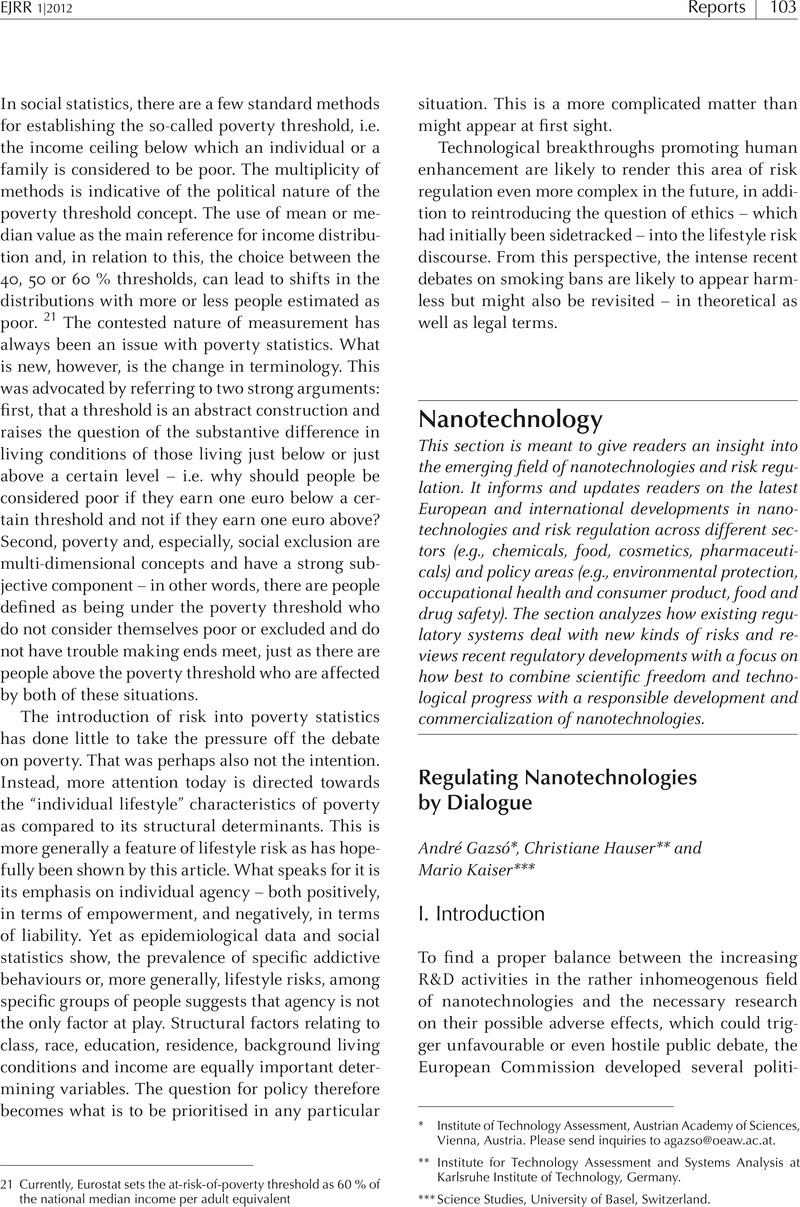Published online by Cambridge University Press: 20 January 2017

1 European Commission, Towards a European strategy for nanotechnology (COM(2004)338), 2004.
2 European Commission, Nanosciences and nanotechnologies: An action plan for Europe, 2005-2009 (COM(2005)243), 2005.
3 Federal Ministry of Education and Research (BMBF), Nano-Initiative – Action Plan 2010, Bonn, 2007.
4 Federal Office of Public Health FOPH, State Secretariat for Economic Affairs SECO, Federal Office for the Environment FOEN, Action Plan – Synthetic Nanomaterials, 2008.
5 Federal Ministry of Agriculture, Forestry, Environment and Water Management et al., Austrian Nanotechnology Action Plan, 2010.
6 BMBF, Aktionsplan Nanotechnologie 2015 (Bonn, Berlin 2010).
7 Irwin, Alan, “The Politics of Talk: Coming to Terms with the ‘New’ Scientific Governance”, 36(2) Social Studies of Science (2006), pp. 299–320 CrossRefGoogle Scholar.
8 Rowe, Gene and Frewer, Lynn J., “A Typology of Public Engagement Mechanisms”, 30(2) Science, Technology, & Human Values (2005), pp. 251–290 CrossRefGoogle Scholar.
9 Wilsdon, James and Willis, Rebecca, See-through science: why public engagement needs to move upstream (London: Demos, 2004)Google Scholar.
10 Ortwin Renn and Mike Roco, “White Paper on Nanotechnology – Risk Governance”, International Risk Governance Council, Geneva, available on the Internet at <http://www.irgc.org/IMG/pdf/IRGC_white_paper_2_PDF_final_version-2.pdf> (last accessed on 16 January 2012).
11 ETC Group, “The Big Down: From Genomes to Atoms”, January 2003, available on the Internet at <http://www.etcgroup.org/upload/publication/171/01/thebigdown.pdf> (last accessed on 16 January 2012).
12 The Royal Society & Royal Academy of Engineering, Nanoscience and nanotechnlogies: opportunities and uncertainties, Report of 29 July 2004, available on the Internet at <http://www.nanotec.org.uk/finalReport.htm> (last accessed on 16 January 2012).
13 Rip, Arie and van Amerom, Marloes, “Emerging De Facto Agendas Surrounding Nanotechnology: Two Cases Full of Contingencies, Lockouts, and Lock-Ins” in Kaiser, Mario, Kurath, Monika, Maasen, Sabine and Rehmann-Sutter, Christoph (eds.), Governing future technologies: Nanotechnology and the Rise of an Assessment Regime (Dordrecht: Springer, 2010)Google Scholar.
14 Rose, Nikolas and Miller, Peter (1992), “Political Power beyond the State: Problematics of Government”, 43(2) The British Journal of Sociology (1992), pp. 173–205 CrossRefGoogle Scholar.
15 Habermas, Jürgen, Moral consciousness and communicative action (Cambridge, MA: MIT Press, 1992)Google Scholar.